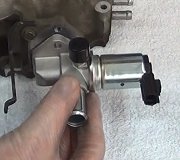I've seen the term before but didn't bother to ask until I saw it a second or third time. I love plays on words but I have to be careful to not use them here because people can't see my facial expressions or hear my inflection. Don't want the meaning of my helping comments to get lost in my misguided humor. I'll have to add "crunk" to my vocabulary list.
Now, to get back to the problem at hand, the first thing to check is if you're getting a nice "idle flare-up" when you start the engine. That is where the engine speed goes instantly up to around 1500 rpm for two or three seconds, then comes back down to about 800 rpm. If that occurs, it proves the automatic idle speed motor is working, the Engine Computer has control of it, and the air passage it opens is not blocked with carbon. It was common for that passage to become plugged with carbon ten or fifteen years ago, but that rarely occurs now due to better additives in the fuel.
Another test can be performed by the dealer with their DRB3 scanner. By pressing a few buttons the engine speed can be increased to 2000 rpm in 200 rpm steps. That will also prove the automatic idle speed motor is working. The scanner will also show the number of "steps" the computer has commanded the AIS motor to. Out of 256 steps, number 32 is typical for a good-running engine. If you find it is on a much higher step, say 50 or more, the computer wants to increase engine speed but isn't getting the desired results. If you find it is on a lower step such as 0 to 25, the engine speed is too low because the computer is requesting that lower speed in response to something. That is rather rare. One possible cause is a cracked magnetic core in the crankshaft position sensor or camshaft position sensor. Even though the spark plugs and injectors are fired correctly, extra pulses can be generated by those cracked sensors, and will be interpreted as more revolutions per minute than are actually occurring. The computer will think it needs to reduce engine speed.
If you do not get a nice idle flare-up, the AIS motor might not be working or the Engine Computer may have lost its memory from something being disconnected. Usually that is the battery, but there are other fuses and connectors that can do the same thing. The computer will relearn "minimum throttle" and know when to be in control of idle speed after you do the coasting procedure in my first reply.
If the throttle position sensor was recently replaced, it will report a different voltage at idle than the old sensor. No two sensors are exactly alike. If that lowest voltage is higher than that from the old sensor, the computer will think you still have your foot on the gas pedal so it won't try to maintain idle speed.
The computer can set fault codes in memory related to the automatic idle speed motor, but only from performing electrical tests on it. It has no way of knowing if the motor moved to the position it was commanded to.
I've also read about low idle speed problems being caused by poor ground wire connections. There should be four ground wires for the Engine Computer. Never ran into that problem myself but it might be worth checking those wires where they're bolted to the body.
Saturday, April 2nd, 2011 AT 6:07 AM


